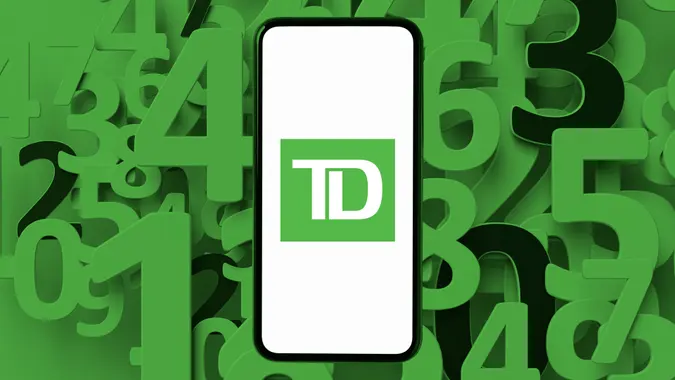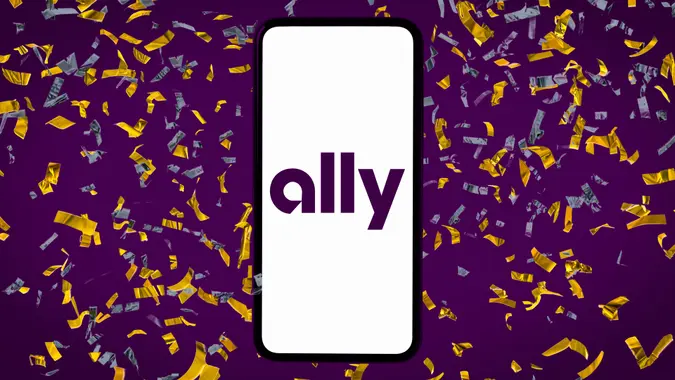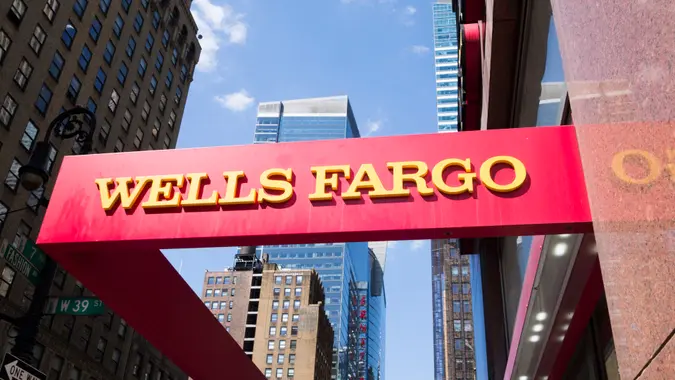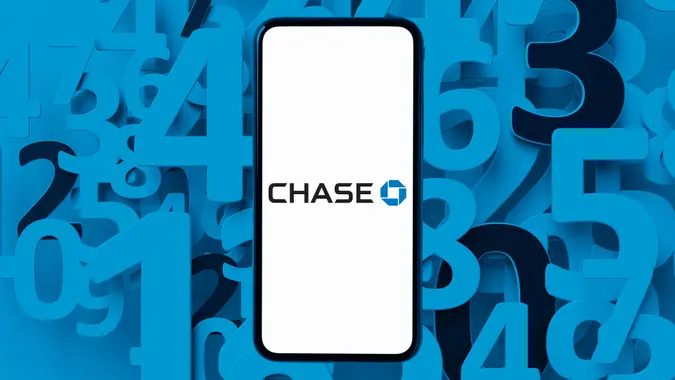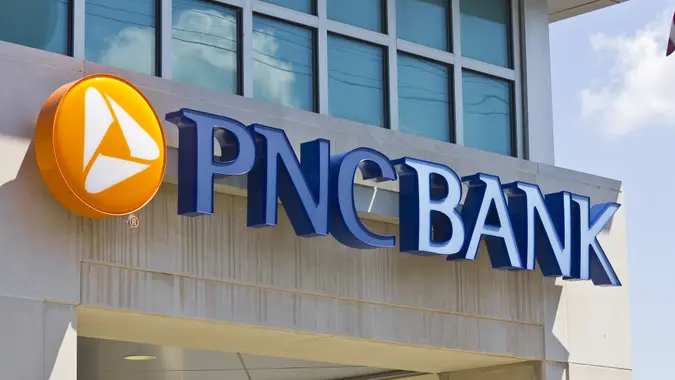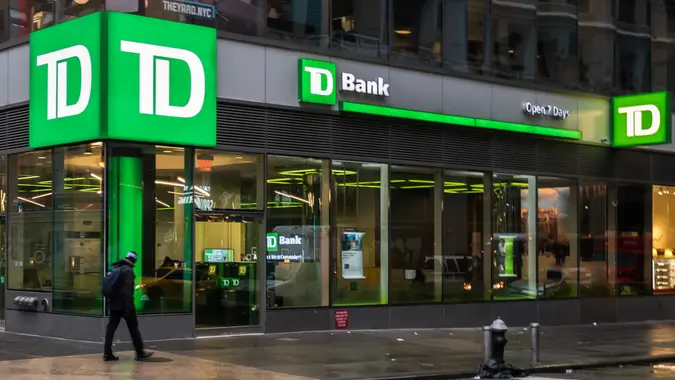30 Largest Banks in the US
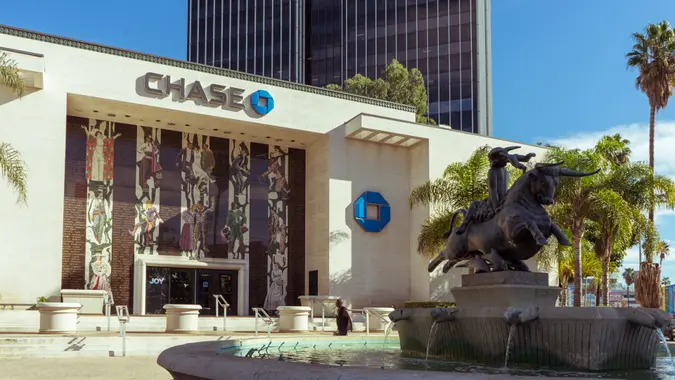
Commitment to Our Readers
GOBankingRates' editorial team is committed to bringing you unbiased reviews and information. We use data-driven methodologies to evaluate financial products and services - our reviews and ratings are not influenced by advertisers. You can read more about our editorial guidelines and our products and services review methodology.

20 Years
Helping You Live Richer

Reviewed
by Experts

Trusted by
Millions of Readers
The United States has a highly developed and intricate banking system with a variety of financial institutions, from local credit unions to large banks with a global presence. They all play a vital role in the country’s economy and provide banking services for a diverse group of customers.
Banks in the U.S. also range in size, typically measured by the total assets the bank manages. Four of the largest U.S. banks — JPMorgan Chase, Bank of America, Wells Fargo and Citi® — hold trillions of dollars in assets.
What Is the No. 1 Bank in America?
Today, the No. 1 bank in America, based on assets, is JPMorgan Chase. Here is the full list of the 30 biggest banks in America based on consolidated assets held along with the total value of their assets and headquarters.
| Bank | Headquarters | Total |
|---|---|---|
| JP Morgan Chase | New York | $3.4 trillion |
| Bank of America | Charlotte, N.C. | $2.5 trillion |
| Citi® | New York, N.Y. | $1.7 trillion |
| Wells Fargo | San Francisco | $1.7 trillion |
| U.S. Bank | Minneapolis, Minn. | $650.7 billion |
| PNC Bank | Pittsburgh | $557.5 billion |
| Truist | Charlotte, N.C. | $535 billion |
| Goldman Sachs | New York | $521 billion |
| Capital One | McLean, Va. | $475.6 billion |
| TD Bank | Cherry Hill, N.J. | $367.2 billion |
| Bank of New York Mellon | New York | $332.5 billion |
| State Street Corporation | Boston | $293.2 billion |
| BMO | Chicago | $265.7 billion |
| Citizens Bank | Providence, R.I. | $221.8 billion |
| Fifth Third Bank | Cincinnati | $213.8 billion |
| First Citizens Bank | Raleigh, N.C. | $213.7 billion |
| Morgan Stanley Bank | New York | $209 billion |
| M&T Bank | Buffalo, N.Y . | $207.8 billion |
| Morgan Stanley Private Bank | New York | $203.3 billion |
| Huntington | Columbus | $188.73 billion |
| Ally Bank | Detroit | $186.1 billion |
| Keybank | Cleveland | $185.9 billion |
| American Express | New York | $180.4 billion |
| HSBC | New York | $165.2 billion |
| Regions Bank | Birmingham, Ala. | $151.3 billion |
| Northern Trust | Chicago | $150.3 billion |
| Discover Bank | Riverwoods, Ill. | $149.4 billion |
| Flagstar Bank/New York Community Bank | Hicksville, N.Y. | $116.3 billion |
| Santander Bank | Boston | $100.5 billion |
| City National Bank | Los Angeles | $93.4 billion |
Top 30 Biggest Banks in the U.S.
The biggest banks in the United States include some familiar names as well as a number of banks you may not know exist. Here is an overview of these financial institutions, with key insights into what sets each one apart and how they grew to where they are today
1. JPMorgan Chase
Headquarters: New York
Estimated total assets: $3.4 trillion
JPMorgan Chase is the largest bank in the U.S., with roughly $3.4 trillion in consolidated assets. Founded more than 220 years ago in New York City, JPMorgan Chase — commonly called Chase — has a nationwide presence, with more than 4,700 branches in 48 states and more than 16,000 ATMs, making it one of the most accessible banks in the country.
2. Bank of America
Headquarters: Charlotte, North Carolina
Estimated total assets: $2.5 trillion
As one of the world’s leading financial institutions, Bank of America, Member FDIC, provides small- and middle-market businesses, individuals, governments and large corporations with investment management, banking and other risk and financial management solutions. It has thousands of ATMs and financial centers, ensuring that its customers can bank when and where they want.
3. Citi®
Headquarters: New York
Estimated total assets: $1.7 trillion
Part of Citigroup, Citi® is a leading global financial services company that provides corporations, consumers, institutions and governments with a wide range of products and services. It has over 600 branches and more than 60,000 fee-free ATMs in the U.S. As one of the first financial institutions to invest in ATMs, Citi® has always focused on technology, allowing it to become a leader in 5G, mobile and digital payments.
4. Wells Fargo
Headquarters: San Francisco
Estimated total assets: $1.7 trillion
Despite ranking fourth in terms of consolidated assets, Wells Fargo offers a broad network of bank branches — more than 5,600 locations across the U.S. — that tops most of its competitors. The bank has successfully tapped into new customer segments and small businesses through its expansive branch and ATM network. It’s also one of the largest mortgage lenders for American homeowners.
5. U.S. Bank
Headquarters: Minneapolis, Minnesota
Estimated total assets: $650.7 billion
U.S. Bancorp traces its history back to 1863 when two bankers founded the First National Bank of Minneapolis. Today, U.S. Bancorp is the parent company of U.S. Bank, the fifth-largest commercial bank in the U.S., with over 2,000 branches in 26 states and one of the largest ATM networks in the U.S. Offering its customers a full range of deposit accounts and financial services, U.S. Bank also successfully expanded its online and mobile banking presence, making it easier for customers to bank when and where they want.
6. PNC Financial Services
Headquarters: Pittsburgh
Estimated total assets: $557.5 billion
The product of a 1983 merger between Pittsburgh National Corporation and Provident National Corporation, PNC Bank is among the top banks in the U.S. due to its specialized perks and services to customers. It’s also one of the largest diversified financial services institutions in the country. The bank offers a full line of products and services, including retail banking, corporate and institutional banking, asset management and wealth management.
7. Truist Financial Corp.
Headquarters: Charlotte, North Carolina
Estimated total assets: $535 billion
In late 2019, BB&T and SunTrust merged to form Truist. Today, this relatively new bank has more than 2,000 branches and more than 3,000 ATMs in the U.S. In addition to consumer and commercial banking, Truist offers a combination of other financial services, including mortgage lending, brokerage accounts, asset management and insurance products. It has made this focus on diversity and inclusion a key differentiator among competitors.
8. Goldman Sachs Group
Headquarters: New York
Estimated total assets: $521 billion
Goldman Sachs is a leading multinational investment bank that provides an extensive range of financial services to governments, corporations, individuals and organizations. Today, Goldman Sachs is one of the largest and most successful investment banks globally, with a presence in more than 60 cities worldwide. It also provides consumer banking products through its Marcus by Goldman Sachs digital banking platform.
9. Capital One
Headquarters: McLean, Virginia
Estimated total assets: $475.6 billion
Capital One’s commitment to digital transformation has been a large factor in the company’s growth and success. The company was founded in 1994 as a credit card issuer and has since expanded its offerings to include auto loans, mortgages and banking products and services. Throughout its history, Capital One has sought to personalize banking relationships and has more than 50 Capital One Cafes around the country as well as branches in New York, Louisiana, Texas, Maryland, Virginia, New Jersey and the District of Columbia.
10. TD Bank
Headquarters: Cherry Hill, New Jersey
Estimated total assets: $367.2 billion
A subsidiary of Canadian multinational Toronto-Dominion Bank, TD Bank operates more than 1,100 stores and 2,600 ATMs in the U.S. and offers a full range of retail, small business and commercial banking products and services throughout the east coast region. Its partnership with the fintech company Moven, a former neobank and current money management software provider, is a testament to TD Bank’s commitment to being “America’s most convenient bank.”
11. Bank of New York Mellon
Headquarters: New York
Estimated total assets: $332.5 billion
Bank of New York Mellon is the oldest bank in the United States — Alexander Hamilton founded it in 1784 as the Bank of New York. The bank was instrumental in the development of the New York Stock Exchange, a move that foretold its present-day operation as an investment company providing investment and wealth management, treasury services and financing for individuals and institutions.
12. State Street Corporation
Headquarters: Boston
Estimated total assets: $293.2 billion
State Street Corporation is a big company with a lot of experience — it’s one of the oldest banks in the United States. The bank does business in more than 100 markets around the world and is the fourth largest asset manager globally. They’ve also invested resources in financial infrastructure, including electronic trading platforms and tokenization as the next frontier in the banking industry.
13. BMO
Headquarters: Chicago
Estimated total assets: $265.7 billion
Formerly known as BMO Harris in the United States, Bank of Montreal rebranded its U.S. operations after merging with Bank of the West in February 2023. The bank opened its doors in 1817, when it became the first bank available in the Canadian colonies. Today, BMO serves personal and commercial customers, offering checking, savings, and investment accounts, as well as loans and credit cards. It’s received numerous awards from Forbes, Bloomberg and J.D. Power.
14. Citizens Bank
Headquarters: Providence, Rhode Island
Estimated total assets: $221.8 billion
Like many of the banks on this list, Citizens Bank has been around for generations. Founded in 1828, Citizens Bank provides full-service banking to consumer and commercial customers in the mid-Atlantic, midwest, and New England. The bank has more than 1,100 branches and a network of 3,400 ATMs. It frequently appears on lists of the best banks in the country and has been recognized for its efforts to build community and promote diversity and equality in the workplace.
15. Fifth Third Bank
Headquarters: Cincinnati
Estimated total assets: $213.8 billion
Fifth Third Bank got its memorable name after the merger of Third National Bank and Fifth National Bank in the 1920s. The bank operates almost 1,100 branches in 11 states: Ohio, Michigan, Florida, Illinois, Indiana, North Carolina, Kentucky, Tennessee, Georgia, South Carolina and West Virginia. This full-service bank offers personal and business accounts, loans and wealth management services. The bank has been recognized for its commitment to ethical business practices and climate-friendly initiatives.
16. First Citizens Bank
Headquarters: Raleigh, North Carolina
Estimated total assets: $213.7 billion
First Citizens Bank operated solely in North Carolina for almost 100 years before expanding into neighboring states with the 1994 purchase of a bank in West Virginia. Today, the bank has more than 550 branches in 23 states. After merging with CIT Bank in January 2022, First Citizens doubled its assets, expanded its presence across the country and assumed the title as the largest family-controlled bank in the United States.
17. Morgan Stanley Bank
Headquarters: New York
Estimated total assets: $209 billion
In the wake of the Great Depression, Congress passed a law establishing a clear division between commercial and investment banking, inspiring Harold Stanley and Henry Morgan to open their namesake investment bank in 1935. Throughout the 20th century, Morgan Stanley expanded operations to more than 40 countries and today has more than 80,000 employees. A leader in global investment banking, Morgan Stanley helps facilitate mergers and acquisitions and initial public offerings. It also assists companies with debt underwriting and financial advising.
18. M&T Bank
Headquarters: Buffalo, New York
Estimated total assets: $207.8 billion
Founded as Manufacturers and Traders Bank in Buffalo, New York, M&T Bank has prioritized community-focused banking throughout its history. Over the years, the bank has been through multiple mergers and name changes, landing on the current name in 1998. As a result of its commitment to its customers and their communities, M&T has established resource groups, like the African American Resource Group, to support customers in the communities where it offers personal and business banking services. Employees also volunteer, providing more than 50,000 hours to date.
19. Morgan Stanley Private Bank
Headquarters: New York
Estimated total assets: $203.3 billion
Created in 1996 after the merger with Dean Witter, Morgan Stanley Private Bank serves ultra-high net worth customers through investment and cash management services, tax and estate planning and lending. Private banking customers work with a relationship manager who typically communicates with them directly over the phone or via email.
20. Huntington Bank
Headquarters: Columbus, Ohio
Estimated total assets: $188.7 billion
Huntington Bancshares provides banking services for consumers, businesses, local governments and non-profit organizations in 11 states. The bank operates almost 1,000 branches in Ohio, Colorado, Florida, Illinois, Indiana, Kentucky, Michigan, Minnesota, Pennsylvania, West Virginia, and Wisconsin.. In addition to the traditional branches, the bank has more than 30 offices for private clients.
21. Ally Bank
Headquarters: Detroit
Estimated total assets: $186.1 billion
Ally Bank may be known for being a top-rated online bank, but it’s been around for longer than the internet. The bank opened in 1919 as a financing vehicle for General Motors dealers who needed funds to purchase inventory and later expanded operations to provide financing for customers buying cars and trucks. GMAC Bank debuted in 2000, changing its name to Ally Bank nine years later. By 2012, Ally claimed more than one million customers and now offers a range of products, including high-yield savings accounts, certificates of deposit, mortgages and investment accounts.
22. Keybank
Headquarters: Cleveland
Estimated total assets: $185.9 billion
Although its headquarters are in Ohio, KeyBank originally opened its doors in Albany, New York almost 200 years ago. Today, it operates more than 1,000 branches in 15 states (including Alaska), where it offers personal and business banking services and wealth management. Although its one of the biggest banks in the country, KeyBank remains dedicated to the communities where it operates and has been consistently recognized as a community-minded company that honors diversity among its employees and customers.
23. American Express
Headquarters: New York
Estimated total assets: $180.4 billion
Founded in 1850 as a freight company, American Express is best known for its selection of credit cards and travelers’ checks. In 1958, the company debuted its first credit card as an alternative to travelers’ checks, followed by a business credit card in 1966. In 2008, the company launched its first savings account, and it rolled out Kabbage Checking for small business owners in 2021, CNBC reported. A rewards checking account for personal customers followed a year later.
All information about American Express has been collected independently by GOBankingRates and has not been reviewed or approved by American Express. The Kabbage and American Express® Rewards Checking is not available through GOBankingRates.
24. HSBC
Headquarters: New York
Estimated total assets: $165 billion
In 1865, a Scotsman opened The Hongkong and Shanghai Banking Corporation Limited to provide banking services for businesses in Hong Kong. Today, HSBC is one of the largest banks in the world and now serves about 42 million customers in 62 countries. For customers in the United States, HSBC offers bank accounts, credit cards and home loans and provides services for those who have recently arrived in the country or who are planning to move abroad.
25. Regions Bank
Headquarters: Birmingham, Alabama
Estimated total assets: $151.3 billion
Regions Bank opened its doors in 1971 when the Federal Reserve approved the merger of the Exchange Security Bank of Birmingham, First Bank of Huntsville and First National Bank of Montgomery. The new bank had combined assets totaling $446 million. After a series of acquisitions and mergers in the following decades, Regions Bank now has around 1,400 branches in the southern and midwestern U.S. This full-service bank works with consumer and commercial customers, providing banking products, wealth management and mortgages.
26. Northern Trust
Headquarters: Chicago
Estimated total assets: $150.3 billion
Northern Trust was founded in 1889 with the intent to provide valuable banking services backed by integrity and ethical practices. The bank played an integral role in the 1893 World’s Fair, opening an on-site branch for vendors and visitors to use during their stay. It later expanded operations with lines of credit and was one of the first banks to give employees benefits, open checking accounts for women and process checks electronically. Today, the private bank serves high-net-worth individuals and families, providing products and service such as bank accounts, credit services and corporate loans.
27. Discover Bank
Headquarters: Riverwoods, Illinois
Estimated total assets: $149.4 billion
Discover started out as a charge card launched by Sears, Roebuck and Co. in 1986. The company went through a few acquisitions and mergers, eventually changing its name to Discover Bank after acquiring Greenwood Trust Company in 2000. In 2013, Discover debuted a checking account that paid customers cash for each purchase made with a debit card. Today, the bank offers a full range of products, including checking and savings accounts, CD accounts, retirement accounts and loans.
28. Flagstar Bank/New York Community Bank
Headquarters: Hicksville, New York
Estimated total assets: $116.3
One of the newer banks on the list of the largest banks in the United States, Flagstar Bank merged with New York Community Bank in 2022 and now operates under the parent company New York Community Bancorp. The new bank has 420 branches in the Northeast and Midwest as well as 134 private banking teams. It has a significant presence in the residential mortgage market, as it services more than one million accounts.
29. Santander Bank
Headquarters: Boston
Estimated total assets: $100.5 billion
Santander Bank formed in 1857 to support trade taking place between ports in Spain and Latin America. It’s the only bank on this list established by a royal decree, and it also holds the title of largest bank in Spain. Santander started offering retail and commercial banking services in the U.S. in 2010. It has 415 branches in the United States and serves more than 4 million customers. More than one million of them take advantage of the bank’s digital banking services.
30. City National Bank
Headquarters: Los Angeles
Estimated total assets: $93.4 billion
Known as the “bank to the stars,” City National opened its doors in 1953 in Beverly Hills, eventually becoming the largest bank in Los Angeles. In 2015, Royal Bank of Canada acquired City National, but it remains headquartered in southern California. City National continues playing a prominent role in the local community, having donated millions of dollars to local non-profit organizations and community groups supporting education, housing and environmental initiatives.
Takeaway
The biggest banks in America offer a wide range of products and services to consumers, businesses and institutions. These banks are some of the oldest financial institutions in the country, with extensive histories, substantial resources and dedication to digital transformation. They are well-positioned to continue serving the financial needs of Americans in the years ahead and continue exploring new ways to serve customers.
Bank size isn’t the only factor to consider when choosing a bank, but a bigger bank is a suitable choice for some people. If you prefer a bank with a large network of branches and ATMs or want access to a full range of banking products, opening a bank account account at one of these financial institutions could be the start of a lifelong relationship.
Kiran Shahid, Caitlyn Moorhead and Daria Uhlig contributed to the reporting for this article.
Data is accurate as of April 21, 2024, and is subject to change.
Editorial Note: This content is not provided by American Express. Any opinions, analyses, reviews, ratings or recommendations expressed in this article are those of the author alone and have not been reviewed, approved or otherwise endorsed by American Express. American Express credit card products are not available through GOBankingRates.com.
Editorial Note: This content is not provided by any entity covered in this article. Any opinions, analyses, reviews, ratings or recommendations expressed in this article are those of the author alone and have not been reviewed, approved or otherwise endorsed by any entity named in this article.
Editorial Note: This content is not provided by Chase. Any opinions, analyses, reviews, ratings or recommendations expressed in this article are those of the author alone and have not been reviewed, approved or otherwise endorsed by Chase.
Our in-house research team and on-site financial experts work together to create content that’s accurate, impartial, and up to date. We fact-check every single statistic, quote and fact using trusted primary resources to make sure the information we provide is correct. You can learn more about GOBankingRates’ processes and standards in our editorial policy.
- Board of Governors of the Federal Reserve System. "Large Commercial Banks."
 Written by
Written by  Edited by
Edited by 






